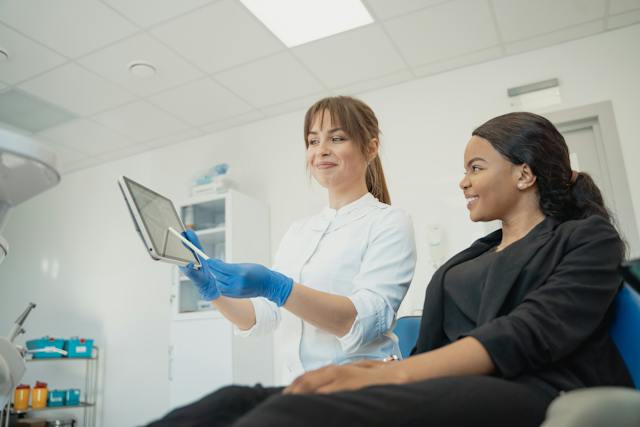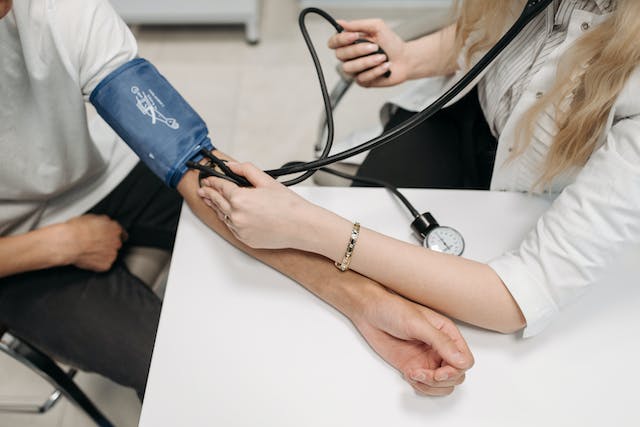Smart Goals for Dental Hygienists
Dental hygienists stand at the forefront of patient care, advocating for oral health and fostering a preventive approach to dentistry. Dental hygienists shoulder the responsibility of not only ensuring optimal oral hygiene but also contributing significantly to overall patient well-being.
In this article, we break down 10 smart goals for dental hygienists that will enhance clinical proficiency and guide dental hygienists towards professional excellence. The key goals listed below will empower dental hygienists to create lasting impacts, forge stronger connections with their patients, and navigate the path to a fulfilling and successful career in oral healthcare
Table of Contents
Using the SMART Method
As dental professionals committed to the well-being of their patients, dental hygienists can harness the power of goal-setting to enhance their skills, contribute to practice efficiency, and continuously improve patient care. One effective approach to attaining our smart goals for dental hygienists is following the concept of the SMART method.
There are five main objectives to the SMART method – Specific, Measurable, Achievable, Relevant, and Time. These objectives can elevate individual performance, contribute to the success of dental practices, and ultimately lead to improved oral health outcomes for patients.
Smart Goals for Dental Hygienists

In the ever-evolving field of dentistry, dental hygienists play a pivotal role in preventative dental care. Whether you’re a seasoned practitioner seeking new challenges or a recent graduate navigating the early stages of your career, understanding and setting strategic goals can be the catalyst for transformative growth.
Below are our top 10 SMART goals for dental hygienists to improve their clinical skills in the operator and improve patient care.
1. Increase Tailored Patient Education
As prevention specialists, dental hygienists play a key role in improving their patient’s oral health. Tailoring patient education to individual needs ensures that each patient receives information relevant to their oral health status, lifestyle, and potential risk factors. This personalized approach can lead to more effective and meaningful education.
- Specific: Provide customized oral hygiene education to at least 90% of patients and give them specific goals to achieve.
- Measurable: Track the tailored goals given to each patient and if they were achieved by their next visit.
- Achievable: Implement educational materials and demonstrations during appointments. Recommend specific products for the patient to use.
- Relevant: Improves patient oral health and compliance with home care.
- Time: Achieve the goal within the next six months.
2. Enhance Interpersonal Communication
Dental procedures can be complex and unfamiliar to patients. Enhancing communication allows dental hygienists to explain treatments, procedures, and preventive measures in a way that patients can understand, making them more comfortable with the care they receive.
Dental hygienists who can adapt their communication style to different cultural norms foster inclusivity and make patients feel valued and respected. Improved communication enables dental hygienists to provide relevant information, empowering patients to make informed decisions about their dental care.
- Specific: Improve communication skills during patient interactions.
- Measurable: Receive positive feedback from at least 90% of surveyed patients.
- Achievable: Attend communication workshops or seek feedback for improvement.
- Relevant: Enhances patient satisfaction and builds trust.
- Time: Demonstrate improvement in communication within the next three months.
3. Improve Clinical Efficiency
Efficient workflows help optimize patient scheduling and appointment management, ensuring that patients are seen promptly and the practice operates smoothly. Improving clinical efficiency enables dental hygienists to provide timely treatment and interventions. This is especially important for addressing preventive measures and early intervention, contributing to better overall oral health outcomes.
- Specific: Reduce appointment turnover time by 15%.
- Measurable: Track the time spent on each patient appointment.
- Achievable: Streamline procedures and improve time management skills.
- Relevant: Enhances overall clinic productivity and patient satisfaction.
- Time: Achieve the reduction goal within the next three months.
Check out our Daily Patient Planner for Dental Hygienists. This digital download will help save time throughout the day and improve efficiency.
4. Increase Patient Recall Rate
Increasing the patient recall rate is a proactive strategy that not only benefits the oral health of patients but also contributes to the success, growth, and sustainability of the dental practice. It aligns with a preventive care approach and fosters lasting relationships between dental hygienists and their patients.
Regular interactions during recall appointments foster stronger patient-provider relationships. Patients who regularly return for check-ups are more likely to feel connected to their dental hygienist and the dental practice, leading to increased loyalty.
- Specific: Improve patient recall rate by 20%.
- Measurable: Track the number of patients returning for follow-up appointments.
- Achievable: Implement a recall system and follow up with patients proactively.
- Relevant: Ensures regular dental check-ups for better oral health.
- Time: Achieve the recall rate improvement within the next six months.
5. Upholding Infection Control Compliance
Our list of smart goals for dental hygienists is infection control. Infection control compliance is a fundamental aspect of responsible and ethical dental practice. It protects patients, supports a safe working environment, and upholds the standards of professionalism in the field of dental hygiene.
Ongoing education in infection control is essential for dental hygienists. Staying informed about the latest guidelines and technologies supports professional development and ensures that infection control practices align with current best practices.
- Specific: Ensure 100% compliance with infection control protocols.
- Measurable: Conduct regular audits and track adherence to protocols.
- Achievable: Continue educating yourself through courses that correspond with your license requirements.
- Relevant: Ensures a safe and hygienic environment for patients and staff.
- Time: Achieve full compliance within the next quarter.
6. Enhance Continuing Education

Continuing education is a highly beneficial and one of our most essential goals for dental hygienists. Expanding your knowledge of dentistry offers a range of advantages for both individual practitioners and the dental profession as a whole.
Dentistry is a dynamic field with ongoing advancements in technology, treatment modalities, and research. Continuing education ensures that dental hygienists stay abreast of the latest developments, allowing them to provide the best and most up-to-date care for their patients.
- Specific: Complete one relevant continuing education course within the next month.
- Measurable: Keep track of continuing education credits to complete the necessary amount for licensure.
- Achievable: Identify suitable courses and allocate time for learning.
- Relevant: Stay updated with the latest advancements in dental hygiene.
- Time: Complete all necessary continuing education credits to keep an updated license.
7. Improve Ergonomics and Prevent Work-Related Strain
Good ergonomics help prevent musculoskeletal disorders, such as neck pain, back pain, and carpal tunnel syndrome, by reducing the physical strain associated with the profession. Proper ergonomics for a dental hygienist is a proactive measure that addresses the physical, mental, and professional well-being of practitioners.
By reducing the physical strain and stress associated with dental tasks, good ergonomics can contribute to the longevity of a dental hygienist’s career. Practitioners who prioritize ergonomics are less likely to experience career-limiting injuries or burnout.
- Specific: Implement ergonomic changes to reduce work-related strain.
- Measurable: Track instances of discomfort or strain reported by staff.
- Achievable: Consult with an ergonomic specialist and make necessary adjustments.
- Relevant: Ensures a healthy and comfortable work environment.
- Time: Implement changes within the next two months.
Switching to the best saddle chair for dental hygienists will help promote proper body alignment and positioning next to your patient. To help achieve this goal out of our top goals for dental hygienists, check out our article The Best Saddle Chairs for Dental Hygienists.
8. Implement Oral Cancer Screenings
Oral cancer is a significant public health concern, with a relatively high incidence making it one of our smart goals for dental hygienists. Oral cancer screenings conducted by dental hygienists enable the early detection of abnormalities, potentially identifying oral cancer at its initial stages.
Integrating oral cancer screenings into routine dental examinations demonstrates a commitment to comprehensive patient care. It aligns with the preventive approach to dentistry, emphasizing the importance of early detection and intervention.
- Specific: Incorporate oral cancer screenings for 100% of patients.
- Measurable: Track the number of screenings conducted each month in the clinical notes.
- Achievable: Integrate screening into all routine examinations and assessments.
- Relevant: Early detection of oral cancer improves the patient’s potential outcome.
- Time: Fully implement screenings within the next three months.
9. Integrate Blood Pressure Measurements

One of our smart goals for dental hygienists is blood pressure screenings. Taking blood pressure at dental appointments is important for dental hygienists for several reasons, emphasizing the interconnectedness of oral health and systemic health
Regular blood pressure monitoring helps identify patients at risk of medical emergencies during dental procedures. Individuals with uncontrolled hypertension may be at an increased risk of complications, and awareness allows for appropriate precautions and modifications to dental treatment plans.
- Specific: Integrate blood pressure measurements into the routine assessment during every dental appointment.
- Measurable: Achieve a 90% compliance rate in recording blood pressure readings for patients during dental appointments.
- Achievable: Review proper blood pressure measurement techniques and incorporate the necessary equipment.
- Relevant: Enhance patient care by systematically monitoring blood pressure, contributing to the early detection of potential health issues.
- Time: Fully implement the practice of measuring blood pressure in 100% of dental appointments within the next three months.
10. Conduct Regular Periodontal Probing
Periodontal probing is a critical component of dental hygiene assessments. Our smart goals for dental hygienists include total preventative care. The data obtained from periodontal probing assists dental hygienists in customizing treatment plans based on the specific needs of each patient.
Periodontal probing findings are essential components of patient records. Comprehensive documentation of pocket depths, clinical attachment levels, and other periodontal parameters supports continuity of care
- Specific: Conduct and document periodontal probing for all adult patients during routine recall appointments.
- Measurable: Achieve 100% compliance in performing and documenting periodontal probing for adult patients in the dental practice at least once a year.
- Achievable: Review proper technique for periodontal probing and ensure the availability of necessary instruments in the dental examination setup.
- Relevant: Enhance the quality of patient care by systematically evaluating and monitoring periodontal health, enabling early detection of periodontal issues and facilitating proactive treatment.
- Time: Fully conduct and document periodontal probing for all adult patients within the next six months.
Take Home Smile Store
Visit our Take Home Smile Store for educational products and printables to help with oral hygiene in patients and improve your daily workflow. Certain products even come with a customizable feature to support your dental office.



